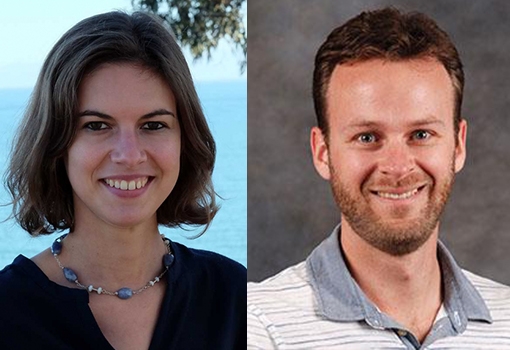People tend to only think about energy storage when their laptop or cellphone batteries are running out of juice. However, energy storage is a key concept for utility companies, who are constantly managing the supply and demand of energy on the electrical grid. The more variability that exists in supply and demand, the more difficult it is to stabilize the grid. Battery energy storage systems (BESSs) provide scalable and modular utilities to mitigate fluctuations in energy supply and demand. They charge by drawing in excess power from the grid that can be stored, and they inject power back into the grid during times of high demand. Remaining problems with such systems include their limited capacity and unavailability in several parts of the world. Therefore, there is a constant need for new energy storage solutions.
Two assistant professors from UC Santa Barbara, Raphaële Clément from the Materials Department and Gabriel Ménard from the Chemistry and Biochemistry Department, are teaming up to design a novel energy storage solution for the smart grid, in the form of a photoactive redox flow battery (P-RFB).
Like all batteries, RFBs store electrical energy as chemical energy and convert that energy back into electricity when needed. A battery has three main components: two terminals made of different chemicals, the anode and the cathode; and the electrolyte, a chemical medium that allows ions to transport chemical energy from one terminal to the other. In order to generate an electric current, ions transport current through the electrolyte while electrons flow between the terminals. RFBs are designed to hold energy in soluble, redox-active molecules that are stored in electrolyte reservoirs. Scaling up batteries to store more power simply requires bigger reservoirs of electrolytes.
Clément and Ménard propose replacing the two-step capture and storage of energy by designing and applying new photoactive electrode materials to RFBs. Photoactive electrodes are electric conductors that, following the absorption of light, trigger energy conversion. The collaboration between the two researchers combines the synthetic inorganic and electrochemical expertise of Ménard with the magnetic resonance (MR) characterization expertise of Clément.
Their project, Synthesis and Advanced Magnetic Resonance Characterization of New Photoactive Materials, was one of four proposals selected to receive inaugural research seed grants by UCSB’s Institute for Energy Efficiency (IEE). The IEE at UCSB is an interdisciplinary research institute committed to improving energy efficiency across three key themes: smart societal infrastructure, computing and communications, and the food-energy-water nexus. Funded by a gift from an anonymous donor, the selected proposals are innovative projects in the early stages of development that align with at least one IEE theme. The seed program is intended to produce preliminary results that the scientists can use to apply for major external funding to further fund and expand their research.
To design and synthesize new photoactive materials and develop new MR techniques, Ménard and Clément plan to use the $50,000 to hire a senior graduate student and pay for the use of the nuclear magnetic resonance (NMR) and electron paramagnetic resonance (EPR) instruments at UCSB’s Materials Research Lab.
The Institute will announce additional seed funding recipients Sept. 18, and 20. Earlier this week, the IEE awarded a seed grant to an interdisciplinary team of researchers who proposed a project that could immediately benefit the citrus industry and potentially benefit farmers who grow other crops. To read more about that project, click here.
Clément and Ménard are two of the four junior faculty who are newly affiliated with the IEE through the seed funding program.

Raphaële Clément (left) and Gabriel Ménard propose designing a photoactive redox flow battery.
